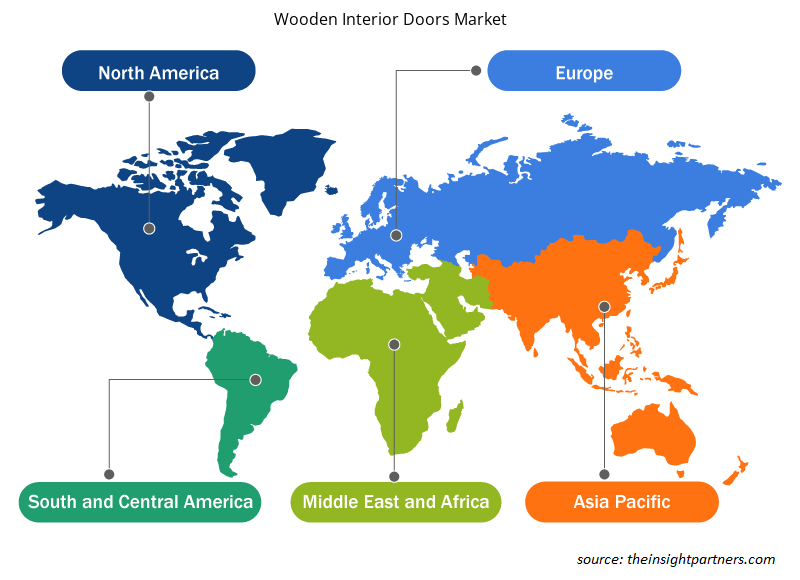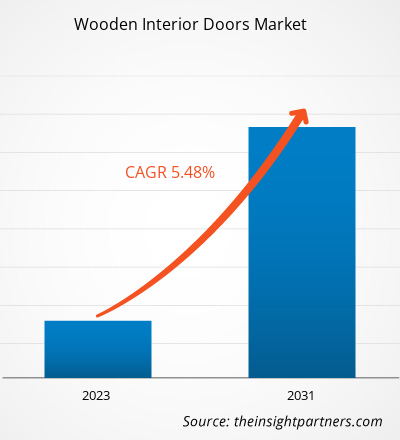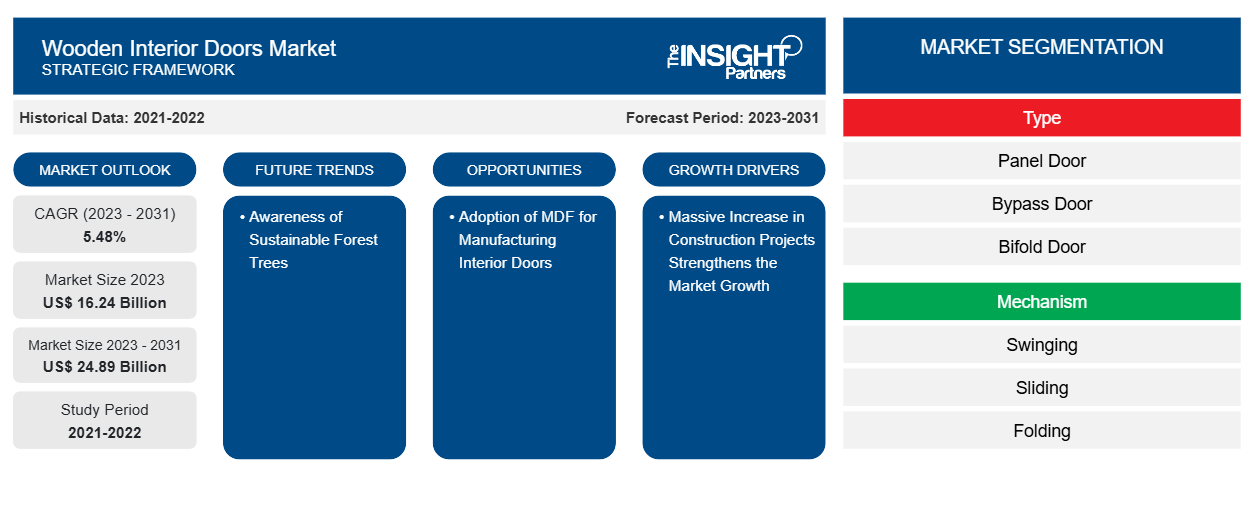Si prevede che il mercato delle porte interne in legno raggiungerà i 24,89 miliardi di dollari entro il 2031, rispetto ai 16,24 miliardi di dollari del 2023. Si prevede che il mercato registrerà un CAGR del 5,48% nel 2023-2031. Secondo il Global Construction 2030, si stima che il volume della produzione edilizia aumenterà dell'85%, raggiungendo i 15,5 trilioni di dollari entro il 2030 in tutto il mondo. Si prevede che Stati Uniti, Cina e India guideranno il percorso e rappresenteranno più della metà della quota di tutta la crescita globale. Inoltre, gli investimenti per rinnovare vecchi edifici e strutture e una crescente inclinazione verso un futuro più verde stanno aumentando la portata degli edifici verdi, il che sta ulteriormente alimentando il settore delle costruzioni.
Analisi di mercato delle porte interne in legno
Nell'era della crescente urbanizzazione, il settore delle costruzioni sta fiorendo a un ritmo enorme. Con l'aumento dei progetti di costruzione, anche la domanda di componenti correlati, tra cui prodotti di arredamento come porte interne, sta aumentando. Pertanto, per tenere il passo con il ritmo della crescente urbanizzazione senza lasciare alcun impatto dannoso sull'ambiente, si sta implementando la selvicoltura sostenibile. La selvicoltura sostenibile si concentra sul salvataggio delle foreste naturali implementando l'imboschimento e la riforestazione, nonché utilizzando tecniche di disboscamento a impatto ridotto.
Panoramica del mercato delle porte interne in legno
Si stima che l'edilizia abitativa continuerà e, pertanto, trovare una soluzione adatta è un must per soddisfare la domanda della popolazione urbanizzata. Si prevede che 3 miliardi di persone (quasi il 40% della popolazione mondiale) richiederanno nuove strutture abitative entro il 2030, il che si traduce in una domanda di circa 300 milioni di nuove abitazioni. Pertanto, la suddetta crescente domanda di edilizia abitativa, unita alla necessità di un ambiente sicuro, sta spingendo il concetto di silvicoltura sostenibile . Questo aspetto avrà un impatto positivo sulla crescita del mercato delle porte interne in legno.
Personalizza questo report in base alle tue esigenze
Riceverai la personalizzazione gratuita di qualsiasi report, comprese parti di questo report, o analisi a livello nazionale, pacchetto dati Excel, oltre a usufruire di grandi offerte e sconti per start-up e università
-
Scopri le principali tendenze di mercato in questo rapporto.Questo campione GRATUITO includerà analisi di dati che spaziano dalle tendenze di mercato alle stime e alle previsioni.
Driver e opportunità del mercato delle porte interne in legno
L'aumento massiccio dei progetti di costruzione rafforza la crescita del mercato
Con l'aumento della popolazione urbana, la necessità di edifici alti è aumentata notevolmente nelle aree urbane. Secondo il Council on Tall Buildings and Urban Habitat (CTBUH), negli ultimi due decenni negli Stati Uniti sono stati costruiti 1.480 grattacieli con altezze superiori a 200 m. Il numero include anche 40 grattacieli residenziali costruiti negli ultimi anni. L'aumento dei lavori di costruzione in ambito residenziale, commerciale e in diversi settori dovuto alla crescente urbanizzazione sta guidando la crescita delle porte interne. Gli enti governativi stanno concentrando ulteriormente l'attenzione sul rafforzamento dello sviluppo edilizio e infrastrutturale, il che sta ulteriormente sostenendo la domanda di porte interne.
Adozione di MDF per la produzione di porte interne
MDF è un prodotto in legno ingegnerizzato generalmente realizzato con fibre di legno riciclate. L'MDF sta diventando il materiale per porte interne più comunemente utilizzato grazie alla sua durevolezza e convenienza. Inoltre, le porte interne in MDF sono più dense del compensato e del truciolato, un altro fattore che attrae sia i settori residenziali che commerciali. Oltre alle caratteristiche sopra menzionate, i bordi estremamente lisci e l'assenza di laminati rendono l'MDF diverso dal truciolato e da altri materiali in legno. Pertanto, la popolarità dell'MDF sta assistendo a una tendenza al rialzo, che dovrebbe offrire opportunità commerciali redditizie per i produttori di porte interne in legno.
Analisi della segmentazione del rapporto di mercato delle porte interne in legno
I segmenti chiave che hanno contribuito alla derivazione dell'analisi di mercato delle porte interne in legno sono tipologia, meccanismo e utente finale.
- In base al metodo, il mercato è suddiviso in porta a pannello, porta bypass , porta a soffietto, porta a scomparsa e altri. Il segmento della porta a pannello ha detenuto una quota di mercato maggiore nel 2023.
- In base al meccanismo, il mercato globale delle porte interne in legno è suddiviso in oscillanti, scorrevoli, pieghevoli e altre. Il segmento oscillante ha detenuto una quota di mercato maggiore nel 2023.
- A seconda dell'utente finale, il mercato globale è diviso in residenziale e non residenziale. Il segmento residenziale ha detenuto una quota di mercato maggiore nel 2023.
Analisi della quota di mercato delle porte interne in legno per area geografica
L'ambito del rapporto sul mercato delle porte interne in legno comprende Nord America (Stati Uniti, Canada e Messico), Europa (Spagna, Regno Unito, Germania, Francia, Italia e resto d'Europa), Asia Pacifico (Corea del Sud, Cina, India, Giappone, Australia e resto dell'Asia Pacifico), Medio Oriente e Africa (Sudafrica, Arabia Saudita, Emirati Arabi Uniti e resto del Medio Oriente e Africa) e Sud e Centro America (Brasile, Argentina e resto del Sud e Centro America). In termini di fatturato, l'APAC ha dominato la quota di mercato delle porte interne in legno nel 2023. L'Europa è il secondo maggiore contributore al mercato globale delle porte interne in legno, seguita dal Nord America. Nel panorama del mercato globale, la Cina è stata tra i maggiori consumatori di MDF nel 2022, detenendo oltre il 50% del volume totale del mercato. Inoltre, la Cina ha superato gli Stati Uniti in termini di consumo di MDF. Bielorussia, Turchia e Polonia sono altri mercati importanti noti per avere i più alti livelli di consumo pro capite di MDF. Si prevede che un trend di consumo così elevato in questi paesi favorirà l'impiego dell'MDF nella produzione di arredi per la casa, comprese le porte interne.
Approfondimenti regionali sul mercato delle porte interne in legno
Le tendenze regionali e i fattori che influenzano il mercato delle porte interne in legno durante il periodo di previsione sono stati ampiamente spiegati dagli analisti di Insight Partners. Questa sezione discute anche i segmenti e la geografia del mercato delle porte interne in legno in Nord America, Europa, Asia Pacifico, Medio Oriente e Africa e America meridionale e centrale.

- Ottieni i dati specifici regionali per il mercato delle porte interne in legno
Ambito del rapporto di mercato sulle porte interne in legno
| Attributo del report | Dettagli |
|---|---|
| Dimensioni del mercato nel 2023 | 16,24 miliardi di dollari USA |
| Dimensioni del mercato entro il 2031 | 24,89 miliardi di dollari USA |
| CAGR globale (2023-2031) | 5,48% |
| Dati storici | 2021-2022 |
| Periodo di previsione | 2023-2031 |
| Segmenti coperti |
Per tipo
|
| Regioni e Paesi coperti |
America del Nord
|
| Leader di mercato e profili aziendali chiave |
|
Densità dei player del mercato delle porte interne in legno: comprendere il suo impatto sulle dinamiche aziendali
Il mercato delle porte interne in legno sta crescendo rapidamente, spinto dalla crescente domanda degli utenti finali dovuta a fattori quali l'evoluzione delle preferenze dei consumatori, i progressi tecnologici e una maggiore consapevolezza dei vantaggi del prodotto. Con l'aumento della domanda, le aziende stanno ampliando le loro offerte, innovando per soddisfare le esigenze dei consumatori e capitalizzando sulle tendenze emergenti, il che alimenta ulteriormente la crescita del mercato.
La densità degli operatori di mercato si riferisce alla distribuzione di aziende o società che operano in un particolare mercato o settore. Indica quanti concorrenti (operatori di mercato) sono presenti in un dato spazio di mercato in relazione alle sue dimensioni o al valore di mercato totale.
Le principali aziende che operano nel mercato delle porte interne in legno sono:
- Concetto SGA Inc
- Azienda di porte Simpson
- Società per azioni Jeld-Wen
- Marvin Ltd
- Masonite International Corp
- Grana del legno Inc.
Disclaimer : le aziende elencate sopra non sono classificate secondo un ordine particolare.

- Ottieni una panoramica dei principali attori del mercato delle porte interne in legno
Notizie di mercato e sviluppi recenti sulle porte interne in legno
Il mercato delle porte interne in legno viene valutato raccogliendo dati qualitativi e quantitativi dopo la ricerca primaria e secondaria, che include importanti pubblicazioni aziendali, dati associativi e database. Di seguito è riportato un elenco degli sviluppi nel mercato delle porte interne in legno e delle strategie:
- A febbraio 2022, Simpson Redi-Prime, uno dei marchi più riconosciuti per porte interne verniciate realizzate in modo eccezionale , ha ampliato la sua linea di prodotti per includere le porte ad angolo tagliato per spazi unici all'interno di una casa. Mentre molti continuano a effettuare ristrutturazioni per adattarsi alle funzioni in continua evoluzione di una casa, l'angolo superiore di una porta ad angolo tagliato Redi-Prime viene spedito pretagliato ad angolo per una vestibilità personalizzata. Il risultato è una soluzione di design appositamente realizzata per qualsiasi applicazione che non possa ospitare una porta interna standard con parte superiore quadrata. (Fonte: Simpson Door Company, comunicato stampa/sito Web aziendale/newsletter)
Copertura e risultati del rapporto di mercato sulle porte interne in legno
Il rapporto "Dimensioni e previsioni del mercato delle porte interne in legno (2021-2031)" fornisce un'analisi dettagliata del mercato che copre le seguenti aree:
- Dimensioni e previsioni del mercato a livello globale, regionale e nazionale per tutti i segmenti di mercato chiave coperti dall'ambito
- Dinamiche di mercato come fattori trainanti, vincoli e opportunità chiave
- Principali tendenze future
- Analisi dettagliata delle cinque forze di Porter
- Analisi di mercato globale e regionale che copre le principali tendenze di mercato, i principali attori, le normative e gli sviluppi recenti del mercato
- Analisi del panorama industriale e della concorrenza che copre la concentrazione del mercato, l'analisi della mappa di calore, i principali attori e gli sviluppi recenti
- Profili aziendali dettagliati con analisi SWOT
- Analisi storica (2 anni), anno base, previsione (7 anni) con CAGR
- Analisi PEST e SWOT
- Valore/volume delle dimensioni del mercato - Globale, Regionale, Nazionale
- Industria e panorama competitivo
- Set di dati Excel
Report recenti
Rapporti correlati
Testimonianze
Motivo dell'acquisto
- Processo decisionale informato
- Comprensione delle dinamiche di mercato
- Analisi competitiva
- Analisi dei clienti
- Previsioni di mercato
- Mitigazione del rischio
- Pianificazione strategica
- Giustificazione degli investimenti
- Identificazione dei mercati emergenti
- Miglioramento delle strategie di marketing
- Aumento dell'efficienza operativa
- Allineamento alle tendenze normative























 Ottieni un campione gratuito per - Mercato delle porte interne in legno
Ottieni un campione gratuito per - Mercato delle porte interne in legno